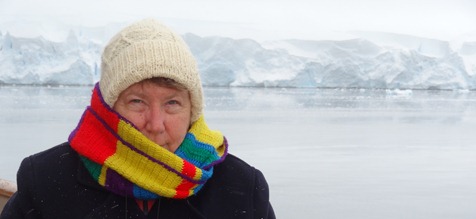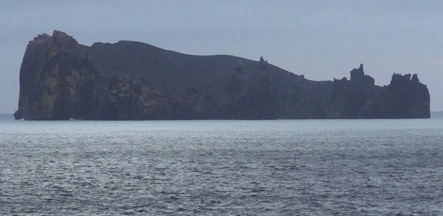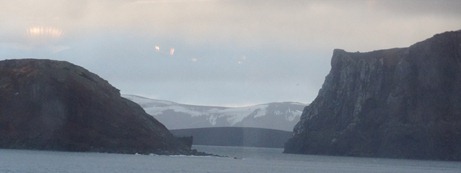Antarctica, Day 2
The whole Antarctic region is protected by aninternational treaty providing that it is neutral territory, that it will not be militarized & that any country that wants to set up a study station anywhere in Antarctica is free to do so. More than 15 countries have scientific stations in Antarctica (including such unlikely ones as Poland and South Korea) and the United states has several, including a base at the South Pole. You may recall that in the early days of the 20th century many men (including Scott & Shackleton) died trying to make it to the South Pole but today members of Congress fly there to have their pictures taken in a few hours.
Anyway, one of the US science stations is called Palmer Station and it is on Anvers Island near the Antarctic Peninsula where, by no coincidence, we were on Friday, February 3. We got up early that day because a group of the staff at Palmer Station was due to arrive at the Prinsendam by Zodiac boat at 6:00 AM, which they did. They have an arrangement with Holland America, which brings them supplies (including fresh fruit) & transports staff (we brought a scientist named Donna who left us at Palmer Station to study penguins) in return for the Palmer Station crew coming aboard to give a presentation on their work (& get a hot shower & meal while they are on board).
We enjoyed their presentation and have learned quite a bit about the science that is being done in Antarctica and the experience of living there (take our word for it, you wouldn’t like it). We cruised around the Anvers Island area until it was time for them to leave. You will note the weather was much better; the sun was even out for much of the time.
You can see in the last picture that the coastal face of the glacier has large cracks in it; those pieces will eventually break off and become icebergs. The bright blue in the cracks, we are told, is from the great pressure on the interior ice, which causes it to form crystals with that deep blue color. Interestingly, as you will see in pictures below, the portion of an iceberg that is under water (80 to 90 percent of an iceberg is under water) also displays a bright blue color, though not as deep as this.
In early afternoon the Palmer Station crew left, returning to the station in a zodiac.
We spent the afternoon cruising northeast toward Deception Island. It was a beautiful afternoon & we had front seats in the Crow’s Nest, which is basically a bar and dancing venue at the very top front of the ship, with panoramic windows all the way across from Port to Starboard. There was a lot of dramatic scenery and interesting icebergs, but first let’s talk about the incredible wildlife viewing.
Several times we saw penguins “porpoising” along the side of the ship. A group of penguins swims along together, leaping into & out of the water like porpoises do (hence the name). I got a short movie of this, which is more evocative, but of course I can’t post it here.
We also saw a couple of seals resting on bergey bits (this is the technical term for floating pieces of ice that aren’t big enough to be icebergs).
We saw Orcas (killer whales, which aren’t really whales) & a bunch of Humpback whales. They are very hard to photograph, because you never know where they are going to surface next & they re-submerge very fast. Also, my camera battery died before most of the Humpback surfacing, which even included one whale that breached high into the air then splashed back down on top of the water (very dramatic!). The first picture is a pair of Orcas; the second is the tail of a diving Humpback whale. Both were lucky blind shots.
There were some birds too. Not too sure about the identifications, but I think the first is a Sooty Albatross, then a Skua sitting on an iceberg.
But best of all, of course, were the penguins. We saw quite a few penguins hanging out on icebergs and bergey bits, so I will put several of them here. If you look very closely in the third picture, there is a line of penguins trooping up the slanting surface to the right. We were told that so many penguins were out of the water because Orcas were in the vicinity.
And of course there was dramatic scenery, with mountains & icebergs, out in the sun for a change. We were struck by how different things look as you move to a different location; a good example is the first two pictues, which are of the same mountain (left in 1st picture & right in 2d).
In the evening we reached Deception Island, which is what Ernest Shackleford & his men were trying to reach after spending most of a year marooned on pack ice. But they couldn’t make it because of the wind & ended up instead on remote Elephant Island, where the crew spent another half year on the beach living under overturned lifeboats while Shackleford made his epic 800 mile trip in a lifeboat to South Georgia Island for help. If you haven’t read a book about this amazing journey you really should. If it had been written as a novel you would dismiss it as an impossible fantasy, but it really did happen.
Anyway, Deception Island is the remains of a volcano. It is a circular piece of land with a large harbor in the middle and only a narrow opening that has too many submerged rocks for a ship our size to get inside. The harbor is the caldera from the volcano. It was quite beautiful, especially since the sun was setting when we were there. The first island/rock we passed looked to me like a whale, & even had a hole on the lower left where they eye of a whale would be, though you probably can’t see it in the photo. The second photo is the entry to the caldera/harbor; the snowy mountains in the center are the opposite wall of the island.
We saw a lot of Pintado Petrels at Deception Island; they flew all over the port side of the ship & landed together in the water in a big group. There was another bird that may be some kind of Albatross, perhaps a Wandering Albatross since upon close inspection it has dark wings & a white head.
Finally, a note. I looked at the blog yesterday, and was disappointed to see that the photos are not lining up the way they do in my drafts, with the small pictures two abreast rather than each on a separate line. Take my word for it, the layout looks better on the drafts than what you are seeing. I also was disappointed to see that in the “In Patagonia” post several of the pictures were badly distorted. I would fix that if I could, but won’t be able to figure out how until I get home (if then). That entry took a particularly long time to post (almost an hour) so I am thinking maybe the distortion was caused by transmission glitches. I hope that hasn’t happened on any of the other blog entries, but internet time is too expensive to review them all. On the chance it was a transmission glitch, I will try to avoid that in future by posting entries only when we are in a port, where internet reception seems to be a little better. I hope you are all enjoying this anyway, despite the technical difficulties. [Note: these issues were finally fixed, long after the voyage ended].
Related
This entry was posted on February 9, 2012 by Rick. It was filed under South America Circumnavigation .







































Hi, Rick. i’ve been enjoying your journal but this is my first comment. While I obviously don’t know others’ experience, I’ve been getting your emails just as you anticipated — 2 abreast for the smaller photos and good picture quality. Keep those photos coming, esp. of the penguins and the towel animals!
When I took the QE2 Boston to Southampton in Oct. 2001 (terrible timing), computer time was $1/minute and some people sat there playing solitaire by the hour. Still my worst example of too much money and total ennui.
February 10, 2012 at 10:03 pm
Thanks Rita. I’m glad it is coming through well for you; one other person wrote me that it looks fine on his computer. But at least a couple of people are getting the picture distortions, and when I signed on using the ship’s wired computers (ie. not wifi), I saw the distorted pictures as well, & they looked pretty awful. I wish I knew what the difference is (& how to resolve it).
By the way, we haven’t played solitaire once on this trip! I can’t believe anyone would do that at $1 a minute, even if they had money to spare. Amazing.
Rick
February 12, 2012 at 11:11 am